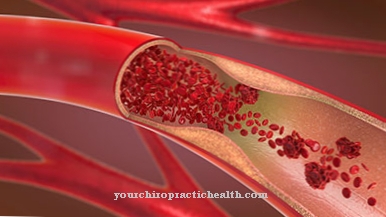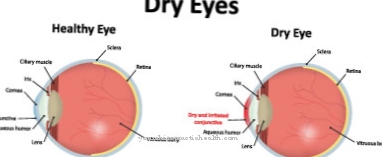Atheromas belong to the group of benign (benign) soft tissue tumors caused by blocked ducts in the sebum glands. Atheromas are not dangerous, but in many cases they should be surgically removed to prevent infection.
What is an atheroma?

© jarabee123 - stock.adobe.com
As an atheroma (also Groats bags or Wheat groats) is a slowly growing, resilient, firm cyst of the epidermis, which is usually due to a blockage of the excretory ducts of the sebum gland system (sebum swelling).
Correspondingly, atheromas manifest themselves in most cases in areas that have a large number of hair follicles, whereby the hairy scalp, neck, neck, face and pubic hair area are particularly predestined. Atheroma only manifests itself symptomatically in the advanced stage or in an unfavorable situation based on a feeling of tension in the affected area.
In addition, many sufferers confuse an atheroma with a pimple at the beginning and try to empty it. These manipulations can develop infections of the atheroma that symptomatically resemble an abscess (reddening, overheating, swelling, pain) with pus formation (pus).
In addition, an atheroma of the skin is differentiated from a vascular atheroma, which, as a focal, inner-walled vascular layer, correlates with arteriosclerosis.
causes
Atheroma is caused by a blockage of the ducts leaving the sebum. This blockage can be caused, among other things, by dried sebum or dead epidermal cells that have deposited in the sebum duct and clog the ducts.
As a result, the sebum gland is no longer able to secrete the sebum required to lubricate the skin. More and more sebum, fat and skin cells accumulate in or below the epidermis and gradually cause the manifestation of an atheroma.
The triggering factors for the processes leading to clogging cannot always be clarified. A genetic predisposition is assumed due to the familial accumulation.
Symptoms, ailments & signs
Atheroma usually leads to very unpleasant symptoms. Those affected primarily suffer from severe swelling in the affected region. This can lead to aesthetic complaints, so that the patients feel uncomfortable with the disease and are ashamed of the symptoms.
Reddening can also occur and the aesthetic complaints continue to increase. Many sufferers continue to suffer from severe pain and overheating of the affected area. A collection of pus can also occur and possibly lead to inflammation.If the atheroma is left untreated, it can spread and affect neighboring regions.
Many patients also have a high fever and, in the worst case scenario, blood poisoning if the inflammation is not treated. In the worst case, atheroma can be fatal, especially on the head. In many cases, the pain from the region also spreads to the neighboring regions, so that there can be significant restrictions in everyday life. However, the symptoms also depend heavily on the exact form and position of the atheroma.
Diagnosis & course
Atheroma can, in most cases, be diagnosed by a close inspection of the skin and palpation (palpation) of the cyst. A dermatologist should be consulted to differentiate from potentially malignant skin changes.
After the surgical removal, the removed tissue is usually examined histologically (fine-tissue) to confirm the benignity. As a rule, the prognosis and the course of atheroma are very good, although recurrences can occur.
Only with an infected atheroma in the cheek or nose area is there a risk of the infection spreading to the brain area, since these structures are connected to one another via the angular vein, through which the germs can also be transported.
Complications
Atheroma is usually harmless, but it can also lead to some complications. First of all, there is a risk that the cyst could become inflamed by an ingrown hair, unsuitable treatment measures, or just pushing around. A bacterial infection causes the atheroma to swell quickly; Depending on the position of the groats bag, severe pain and an increased feeling of pressure can result.
Often there are also typical fever symptoms. If the atheroma presses on the nerve cords, sensory disturbances and numbness can occur in the affected region. The greatest danger is the bursting of the inflamed atheroma. This can lead to serious illnesses, including life-threatening blood poisoning.
Atheroma on the head is particularly dangerous. If it bursts, bacteria and pus can get into the brain and trigger further inflammation there. If the atheroma is not inflamed, the complications are usually limited to slight pain and a feeling of tension in the skin.
If there is an inflammation, the bag of groats will continue to swell and the surrounding tissue area begins to hurt and becomes sensitive to pressure. An inflamed atheroma should be treated promptly by a doctor due to the sometimes serious complications.
When should you go to the doctor?
Atheroma does not necessarily need to be treated by a doctor. However, if pain or severe swelling occurs, the growth is best clarified medically. Groats bags with pus formation also require medical clarification and treatment.
Larger atheromas and those that persist for more than a few weeks or recur in the same region of the body should also receive medical attention. Growths in the genital area, under the arms or on the face require rapid clarification, as they can otherwise open up and become inflamed.
If, in addition to the typical symptoms, fever, chills or other signs of illness occur, the immune system may be overloaded. Medical help is essential in this case. A reddish stripe in the area of the atheroma indicates blood poisoning, which must be treated in the practice or in a hospital.
If an atheroma becomes inflamed or recurs after self-treatment, it is advisable to see a doctor more quickly. If left untreated, the growth can cause severe inflammation, infection or scarring. Patients with skin diseases should discuss atheromas and other skin changes with their family doctor.
Doctors & therapists in your area
Treatment & Therapy
An atheroma is usually treated surgically, although the surgical methods for non-infected and infected atheromas differ.
The surgical removal of a non-infected atheroma is basically uncomplicated and is often carried out on an outpatient basis and, depending on the size of the atheroma, under local anesthesia or twilight sleep. The duct of the sebum, which in most cases can be identified by a black point in the middle of the cyst, the skin spindle and the atheroma capsule are completely removed. Incomplete removal and opening of the capsule increases the risk of recurrence.
Since this risk is particularly increased in the case of an infected atheroma as a result of the inflammatory processes and a complete excision of the capsule is not possible due to the doughy swelling, an operation analogous to the abscess is recommended. The atheroma is first frozen and then split. After carefully removing the pus (pus) and sebum, the affected area is also rinsed with an antiseptic and drainage is placed.
If necessary, antibiotic prophylaxis is indicated in order to kill any bacteria that may have remained in the body and to avoid renewed infection or recurrent inflammation. When the infection has subsided (4 to 6 weeks), the atheroma with capsule and duct is removed as part of another surgical procedure. In the case of more pronounced atheromas, a defect in the form of a dent can be present after the surgical removal, which can be filled and sutured by shifting the subcutaneous fatty tissue.
Outlook & forecast
The prognosis for an atheroma is generally considered to be very good. With the right medical care, the patient can be discharged from treatment within a short time as completely symptom-free. Usually, an outpatient procedure is carried out by a doctor so that the person affected can go home without assistance after just a few minutes or hours. The wound is provided sterile and will heal automatically in the next few days. Another visit to a doctor is usually not necessary.
If the person concerned removes the atheroma on his own responsibility without medical supervision, complications can arise. Inflammation and unwanted scarring are possible. In severe cases, there is a risk of contamination of the wound. Germs can enter the body and cause various diseases.
In addition, blood poisoning threatens a fatal course of the disease. If the wound opens again during the healing process, pathogens can also enter the organism and lead to disorders. Although the prospect of healing an atheroma can be described as very favorable, it cannot be ruled out that further skin impurities may appear in the further course.
Recurrence of atheroma is possible and likely in many patients. Nevertheless, the prognosis does not change even with new growths. The treatment remains the same and it is considered very successful.
prevention
Since the manifestation of atheromas is inherent, it cannot be prevented. Even after complete and professional excision, recurrences, mostly in other areas of the body, can be observed in many cases. However, those affected should not try to manipulate existing atheromas (e.g. by expressing them), as this can provoke an infection.
You can do that yourself
Surgical treatment is usually performed for atheroma. While this is a straightforward procedure, the patient can still take a few steps to avoid complications.
First of all, it is advisable to take it easy on the body. Resting is important, especially in the first days and weeks after the operation. At the same time, the surgical wound must be carefully cared for. The patient should follow the doctor's instructions and seek professional advice in the event of unusual complaints. If the wound becomes infected, a visit to the hospital is indicated.
If the course is positive, make sure that no further bags of groats form. This is achieved by treating the underlying disease. Dry skin can be treated with the help of various care products from specialist shops, while glandular diseases require medical examination and therapy.
In principle, atheromas should not be touched or squeezed out, as this can cause infection and bleeding. In the worst case, the bag of groats breaks open inwards and blood poisoning occurs. That is why atheromas should be carefully observed and examined promptly by a doctor who, in the best case scenario, can open an opening directly.


.jpg)





















.jpg)



